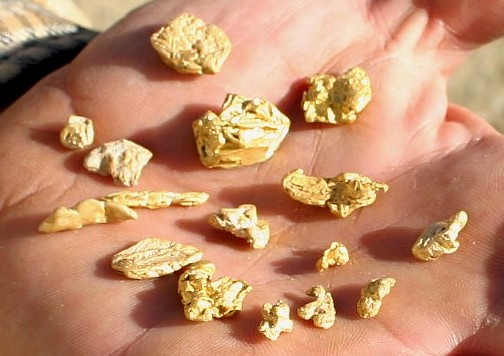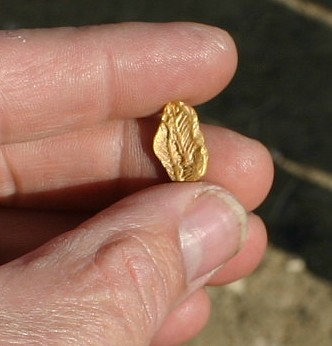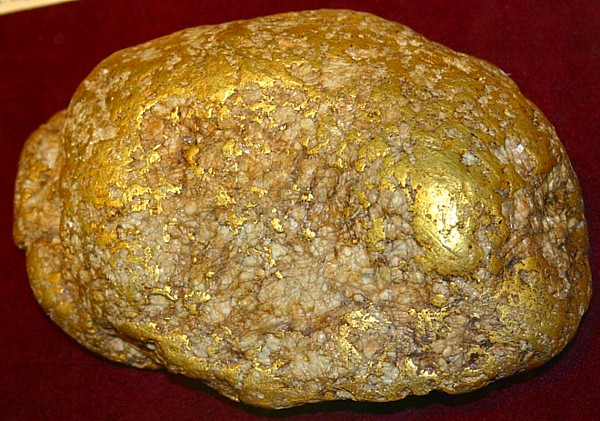|
 |
This spectacular handful of gold nuggets was collected from the famous
placer areas near Rye Patch Nevada in Pershing County. A metal
detector was used to find these pieces of gold while they were still buried
in the dirt. These pieces are known as Chevron gold because of
their beautiful angular crystalline patterns. |
|
|
 |
This
large piece of gold was found in the location known as Ladies Canyon in
Sierra County, California. It shows significant signs of wear and
smoothing from
travel in the stream bed. This nugget weighs slightly over 6 ounces. |
|
 |
The
most basic and common pattern for gold crystals is the octagon. This
beautiful museum quality specimen shows a large number of octagonal whole
crystals that have grown together into a solid mass. The specimen
weighs several ounces and was taken from a gold mine in California in the
late 1800s. |
|
|
|
|
 |
This
small gold nugget shows an unusual herringbone type of crystal pattern which
forms a V shape with a line running down the middle. This form is classic
for Chevron gold, and this piece like the ones pictured above was also mined
in the Rye patch area of northern Nevada. It was also collected using
a metal detector. |
|
 |
This very large heart-shaped gold nugget weighs in at 33.85 Ounces. It was found
on June 16, 2004 at
the
Ganes
Creek mine located near McGrath, in
Southwestern Alaska. it was detected by Steve Burris
of Idaho using a Fisher Gold Bug 2. The nugget was found in an area where
many others had detected, but all the previous detector operators had simply missed
this huge
nugget. |
|
|
 |
This
haul of river polished, smoothed and rounded gold nuggets represents about
three weeks of dredging time on the North Fork of the Yuba River, in Sierra
County California. Not all dredge operators are this successful, but if you
get into a good paystreak of gold, this is what you can find. |
|
|
 |
This
large nugget weighs 156 ounces. Was taken in the Mojave desert of
California with a metal detector in the 1970s. To the best of my knowledge,
this nugget is the largest solid gold mass ever found with a metal detector
and the lower 48 states. It currently resides in the Natural History Museum
of Los Angeles County in downtown LA, where it is on exhibit with a large
number of other gold nuggets both from California and other locations around
the world. For those visiting LA, that collection is worth seeing. |
|
|
 |
The photo
at left shows a fine piece of gold in Quartz taken from the deserts of
Arizona. A metal detector was used to locate it. |
|
|
|
|
|
 |
This
large and unusual gold nugget was taken from the Icabaru district of
Venezuela in South America. |
|
|
 |
Gold
in this ram's horn type formation is extremely unusual and highly valued.
Of the few specimens of this type mined in the US, most come from a single location at
Gilman, Colorado. |
|
 |
Here is another fine crystalline gold specimen from the
Eagle's Nest mine in Placer County, California. |
|
|
 |
This
is another fine piece of Crystalline Chevron placer gold from Rye Patch.
Like most of the other placer gold from this location it was recovered with a metal detector.
The pieces of this type are highly desired by mineral specimen collectors. |
|
|
 |
The
beautiful gold piece shown here is from the big mine at Round Mountain. It
contains very little
quartz, and is mostly gold. |
Recommended
Metal Detectors
For Gold Prospecting:
|
|
 |
Here
is yet another beautiful gold piece from the big mine at Round Mountain. The
gold is formed in a mossy crystalline pattern on the surface of the rock. |
|
 |
This
very large nugget gold specimen is from Alaska, and shows the signs of wear
and tumbling in a river environment. |
|
|
|
|
 |
These
mossy
gold specimens shown here were taken from the Octave mine area near Rich
Hill in Arizona. This collection weighs number of pounds, and is mostly
gold. |
|
|
 |
This
beautiful piece of leaf gold is from the Jamestown area of the
California mother lode. It's hard to believe that in the early days and many fine specimens
like this were simply melted down for their bullion. Very few were actually
preserved and they are quite valuable. |
|
|
 |
Many
prospectors, especially new ones sometimes confuse silver colored materials
that they find in the bottom of the pan. Nearly always this material
is lead or some other less valuable material. Once in awhile however, a
nugget of native platinum such as this one will turn up. Careful
examination is worthwhile, because no one would choose to throw away a
valuable platinum nugget such as this one. |
|
|
 |
While California and Alaska each produce platinum nuggets, there are a
number of worldwide locations for placer platinum. The Ural Mountains in Russia have actually
produced far more platinum than any other location. This unusual looking
nugget is made of platinum and comes from the Ural mountains in Siberian
Russia. At 9 ounces, its pretty good sized. |
|



















